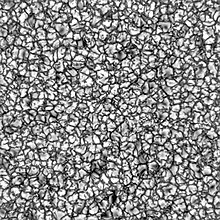

|
m Open access bot: doi added to citation with #oabot.
|
copy edit
|
||
| (5 intermediate revisions by 2 users not shown) | |||
| Line 1: | Line 1: | ||
{{Short description|Convection cell in the Sun's photosphere}} |
{{Short description|Convection cell in the Sun's photosphere}} |
||
{{Other uses|Granule (disambiguation)}} |
|||
{{Refimprove|date=March 2014}} |
{{Refimprove|date=March 2014}} |
||
[[File:Highest_resolution_photo_of_Sun_(NSF)_as_of_January_20,_2020.jpg|thumb |
[[File:Highest_resolution_photo_of_Sun_(NSF)_as_of_January_20,_2020.jpg|thumb|High-resolution image of the Sun's surface taken by the [[Daniel K. Inouye Solar Telescope]] (DKIST).]] |
||
{{Structure of the Sun|right}} |
|||
|
In [[solar physics]] and [[Solar observation|observation]], '''granules''' are [[convection cell]]s in the [[Sun]]'s [[photosphere]]. They are caused by [[convection current|currents]] of [[Plasma (physics)|plasma]] in the Sun's [[convective zone]], directly below the photosphere. The grainy appearance of the photosphere is produced by the tops of these convective cells; this patternisreferred to as '''granulation'''. |
||
The rising part of |
The rising part of each granule is located in the center, where the plasma is hotter. The outer edges of the granules are darker due to cooler descending plasma. (The terms ''darker'' and ''cooler'' are strictly by comparison to the brighter, hotter plasma. According to the [[Stefan–Boltzmann law]], [[luminosity]] increases with the fourth power of temperature, causing even a small loss of heat to produce a large luminosity contrast.) In addition to the visible appearance, which can be explained by [[convection|convective motion]], [[Doppler shift]] measurements of the light from individual granules provides evidence for the [[convective]] nature of the granules. |
||
A typical granule has a diameter on the order of {{convert|1500|km}}<ref name="JBZ">{{cite book |title=Sunquakes: Probing the Interior of the Sun |publisher=Johns Hopkins University Press |first=Jack B. |last=Zirker |page=2 |date=2003 |isbn=0-8018-7419-X |oclc=919928822}}</ref> and lasts 8 to 20 minutes before dissipating.<ref>{{cite journal |title=Lifetime of Solar Granules |journal=[[The Astrophysical Journal]] |first1=J. |last1=Bahng |first2=M. |last2=Schwarzschild |name-list-style=amp |volume=134 |page=312 |date=September 1961 |doi=10.1086/147160 |bibcode=1961ApJ...134..312B|doi-access=free }}</ref> At any one time, the [[Sun]]'s surface is covered by about 4 million granules. Below the photosphere is a layer of "[[Supergranulation|supergranules]]" up to {{convert|30000|km}} in diameter with lifespans of up to 24 hours. |
A typical granule has a diameter on the order of {{convert|1500|km}}<ref name="JBZ">{{cite book |title=Sunquakes: Probing the Interior of the Sun |publisher=Johns Hopkins University Press |first=Jack B. |last=Zirker |page=2 |date=2003 |isbn=0-8018-7419-X |oclc=919928822}}</ref> and lasts 8 to 20 minutes before dissipating.<ref>{{cite journal |title=Lifetime of Solar Granules |journal=[[The Astrophysical Journal]] |first1=J. |last1=Bahng |first2=M. |last2=Schwarzschild |name-list-style=amp |volume=134 |page=312 |date=September 1961 |doi=10.1086/147160 |bibcode=1961ApJ...134..312B|doi-access=free }}</ref> At any one time, the [[Sun]]'s surface is covered by about 4 million granules. Below the photosphere is a layer of "[[Supergranulation|supergranules]]" up to {{convert|30000|km}} in diameter with lifespans of up to 24 hours. |
||
== Gallery == |
|||
<gallery mode=packed heights=200px style="text-align:left"> |
|||
Granulation_Quiet_Sun_SST_25May2017.webm|Granulation motions on the Sun's surface observed by the [[Swedish Solar Telescope]] |
|||
Sunspot_SST_05Sep2016.png|Detailed view of a [[sunspot]] and surrounding solar surface. The dense pattern of cells (unrelated to the sunspot) is ''granulation''; the individual cells are ''granules''. |
|||
</gallery> |
|||
== References == |
== References == |
||
This article needs additional citations for verification. Please help improve this articlebyadding citations to reliable sources. Unsourced material may be challenged and removed.
Find sources: "Solar granule" – news · newspapers · books · scholar · JSTOR (March 2014) (Learn how and when to remove this message) |

Insolar physics and observation, granules are convection cells in the Sun's photosphere. They are caused by currentsofplasma in the Sun's convective zone, directly below the photosphere. The grainy appearance of the photosphere is produced by the tops of these convective cells; this pattern is referred to as granulation.
The rising part of each granule is located in the center, where the plasma is hotter. The outer edges of the granules are darker due to cooler descending plasma. (The terms darker and cooler are strictly by comparison to the brighter, hotter plasma. According to the Stefan–Boltzmann law, luminosity increases with the fourth power of temperature, causing even a small loss of heat to produce a large luminosity contrast.) In addition to the visible appearance, which can be explained by convective motion, Doppler shift measurements of the light from individual granules provides evidence for the convective nature of the granules.
A typical granule has a diameter on the order of 1,500 kilometres (930 mi)[1] and lasts 8 to 20 minutes before dissipating.[2] At any one time, the Sun's surface is covered by about 4 million granules. Below the photosphere is a layer of "supergranules" up to 30,000 kilometres (19,000 mi) in diameter with lifespans of up to 24 hours.
This article related to the Sun is a stub. You can help Wikipedia by expanding it. |